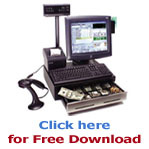- A bar code (often seen as a single word, barcode) is the small image of lines (bars) and spaces that is affixed to retail store items, identification cards, and postal mail to identify a particular product number, person, or location. The code uses a sequence of vertical bars and spaces to represent numbers and other symbols. A bar code symbol typically consists of five parts: a quiet zone, a start character, data characters (including an optional check character), a stop character, and another quiet zone.
A barcode reader is used to read the code. The reader uses a laser beam that is sensitive to the reflections from the line and space thickness and variation. The reader translates the reflected light into digital data that is transferred to a computer for immediate action or storage. Bar codes and readers are most often seen in supermarkets and retail stores, but a large number of different uses have been found for them. They are also used to take inventory in retail stores; to check out books from a library; to track manufacturing and shipping movement; to sign in on a job; to identify hospital patients; and to tabulate the results of direct mail marketing returns. Very small bar codes have been used to tag honey bees used in research. Readers may be attached to a computer (as they often are in retail store settings) or separate and portable, in which case they store the data they read until it can be fed into a computer.
There is no one standard bar code; instead, there are several different bar code standards called symbologies that serve different uses, industries, or geographic needs. Since 1973, the Uniform Product Code (UPC), regulated by the Uniform Code Council, an industry organization, has provided a standard bar code used by most retail stores. The European Article Numbering system (EAN), developed by Joe Woodland, the inventor of the first bar code system, allows for an extra pair of digits and is becoming widely used. POSTNET is the standard bar code used in the United States for ZIP codes in bulk mailing. The following table summarizes the most common bar code standards.
| Bar Code Standard | Uses |
|
Uniform Product Code (UPC) |
Retail stores for sales checkout; inventory, etc. |
|
Code 39 |
Identification, inventory, and tracking shipments |
|
POSTNET |
Encoding zip codes on U.S. mail |
|
European Article Number (EAN) |
A superset of the UPC that allows extra digits for country identification |
|
Japanese Article Number (JAN) |
Similar to the EAN, used in Japan |
|
Bookland |
Based on ISBN numbers and used on book covers |
|
ISSN bar code |
Based on ISSN numbers, used on periodicals outside the U.S. |
|
Code 128 |
Used in preference to Code 39 because it is more compact |
|
Interleaved 2 of 5 |
Used in the shipping and warehouse industries |
|
Codabar |
Used by Federal Express, in libraries, and blood banks |
|
MICR (Magnetic Ink Character Recognition) |
A special font used for the numbers on the bottom of bank checks |
|
OCR-A |
The optical character recognition format used on book covers for the human readable version of the ISBN number |
|
OCR-B |
Used for the human readable version of the UPC, EAN, JAN, Bookland, and ISSN bar codes and for optional human-readable digits with Code 39 and Interleaved 2 of 5 symbols |
|
Maxicode |
Used by the United Parcel Service |
|
PDF417 |
A new 2-D type of bar code that can encode up to 1108 bytes of information; can become a compressed, portable data file (which is what the “PDF” stands for) |














